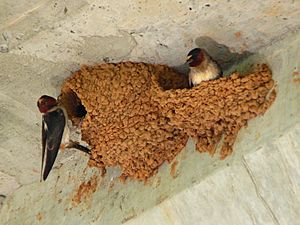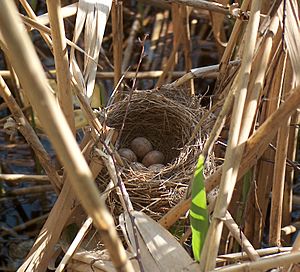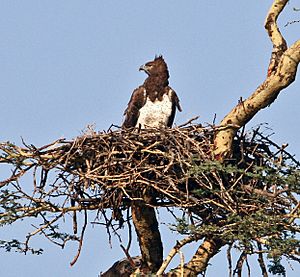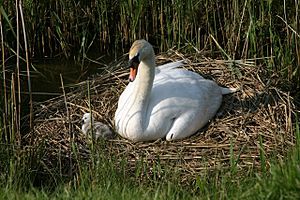Bird nest facts for kids

A bird nest is a special place where a bird lays its eggs and raises its young. Nests come in many shapes and sizes. Some are shaped like cups, others are holes in the ground, and some are just big piles of twigs and leaves. The word "nest" can be used as a noun (the home itself) or a verb (the act of building or living in a nest). Nests can be tiny, like a Bee Hummingbird's nest, which is as small as a thimble. Or they can be huge, like an old eagle's nest, which can be as big and heavy as a car!
Contents
Building a Bird's Home
Usually, the female bird builds the nest, and the male bird helps her. But in some bird families, the male does all the work, or sometimes he does nothing at all!
Birds are clever builders. Many of them "glue" their nests together. They use sticky materials like spider webs, silk, mud, and even their own spit (saliva). Most birds like to make the inside of their nest soft and cozy. Some birds even add herbs and spices to their nests. Scientists believe these herbs might help fight off tiny germs called bacteria.
Different Types of Nests
Cup Nests: A Cozy Bowl
The cup nest is the most common type of bird nest. As its name suggests, it's shaped like a cup or a bowl. Many songbirds build these nests. They often place them in the branches of a tree, sometimes right where one branch meets another. Other birds might stick their nest directly onto a tree branch.
To make their nests strong, birds use sticky materials like mud, rotting wood, animal droppings, spider webs, and caterpillar silk. They might even mix their own saliva with food to help the nest stick firmly to the branch.
Cup nesters use all sorts of materials to build their homes. They use small branches (twigs), grass, leaves, and moss. They also use different things to keep the nest from falling apart. Most cup nesters use rough materials for the outside of the nest. This helps protect the nest and makes it blend in with its surroundings (camouflage). Inside, they put soft, warm materials like moss, fur, feathers, and cotton.
Many cup nesters build their nests close to the ground in low bushes. Sometimes, you might even find one in a potted plant on a porch. Some birds even build their nests right on the ground! Sparrows, cardinals, and many other songbirds (called passerines) like to nest near the ground. This helps keep their babies safe from predators like owls, hawks, and Blue Jays.
There are a few kinds of cup nests. A suspended cup nest hangs down like a bag. It's attached to the branch at the top and sides, but then it drops below. It looks more like a vase than a cup. The mother bird is almost completely hidden when she sits on her eggs. She can even sit on the branch above the nest and bend down to feed her baby birds. Orioles are famous for building amazing, long bag-like nests that hang far below the branch.
The smallest cup nests belong to hummingbirds. They can be as tiny as a thimble, like the Bee Hummingbird's nest. This tiny nest holds eggs that are as small as peas! The largest cup nest is probably the stork's. Its nest can be nine feet deep and six feet wide. Stork nests are so big that smaller birds sometimes build their own nests in the cracks and branches of the stork's nest!
Adherent Nests: Sticking to Surfaces

Adherent nests are nests that stick to buildings, trees, cliffs, or other upright surfaces. Swallows, for example, can build almost perfectly round nests using mud. Some swallow species make cup-shaped nests, while others create jug-like nests with small holes in the sides. They carry little balls of mud in their mouths and mix it with their saliva, making a special clay. As this clay dries, it becomes very hard.
Bird saliva is actually a great glue! Some types of swiftlets even build their entire nest using only saliva. The male swiftlet spits out a long, thin strand of saliva from special glands under its tongue. This saliva is used to make a half-cup nest that sticks to a cave wall. Swiftlets love to build their nests in caves and grottos, and their saliva nests dry very quickly. In China, these saliva nests are considered a special and very expensive food. They are often used to make a soup called Bird's Nest Soup.
Platform Nests: High and Mighty Homes
Platform nests are mostly built by raptors. Raptors are birds that hunt and eat other animals, like eagles and hawks. These nests are usually huge and built very, very high up. You might find them on the sides of cliffs or high in a big tree. It takes many months for these birds to build their nests, adding branch by branch. They often come back to the same nest year after year and keep adding to it. This is why platform nests get so big! For example, a Bald Eagle's nest can weigh as much as a ton, which is about the same weight as a small car. These heavy nests can sometimes even harm the tree they are built in.
A few water birds, like grebes and loons, build platform nests right on the water. These nests float! But they don't just drift away because they are anchored to plants that are attached to the bottom of the water. These birds build nests on water because they don't walk well on land. So, they find a shallow part of the water to build their nests. Then, they don't walk to their nests; they swim to them. When the baby birds are ready, they simply jump into the water and start their life in the water.
Earth-Hole Nests: Homes in the Ground
Earth-hole nests are nests that are built inside the earth. They are burrows (tunnels) dug into the ground or into the sides of cliffs. Birds also like to use abandoned rabbit holes. The Burrowing Owl, for example, only uses holes that have already been dug for its nest.
Puffins are great diggers. They dig tunnels that are usually two to three feet long. At the end of the tunnel, they make a soft nest of feathers and grass and lay their eggs. Puffins can dig these tunnels because they have sharp bills and claws. A puffin can work for hours to make its tunnel. Kingfishers also dig their holes. They can burrow up to six feet into the side of a cliff to lay their eggs.
Ground and Mound Nests: On the Surface
Many birds build their nests right on the ground. After making a small hole, ground and mound nesters line the nest with grass or other materials. Geese even pull feathers from their breasts to make a soft, downy bed for their eggs. Most ducks, geese, and quail like to nest on the ground. Penguins also nest on the ground. They push rocks around their nests to keep them from being washed away by floodwaters. Usually, male birds make ground nests.
The Trumpeter Swan makes a big mound nest, and flamingos make mounds too. Flamingos build their mounds completely out of mud. These mounds can be up to 18 inches high and 12 to 20 inches wide.
Scrape Nests: Barely There
These nests are hardly nests at all! They are just a small dip in the ground or a pile of dead leaves where the bird lays its eggs. Birds that build scrape nests usually have eggs that match the color of dead leaves or rocks. This is important because these eggs are in danger of being eaten by animals like rats, raccoons, snakes, and other egg-eating creatures.
Many birds that use scrape nests try to trick predators. They might pretend they have a broken wing. This makes the predator chase the mother bird, leaving the eggs safe.
Other Bird Facts
Images for kids
-
Some nest linings, like the shell pieces in this Charadrius plover scrape, can stop eggs from sinking into muddy or sandy soil.
-
Other nest linings, such as the lichen in this American golden-plover scrape, might keep the eggs warm or help them blend in.
-
The huge mound nest of the malleefowl works like a compost heap, warming the eggs as the material around them breaks down.
-
The mound nests of flamingos, like these Chilean flamingos, help protect their eggs from changing water levels.
-
Like most birds that nest in burrows, sand martins dig a horizontal tunnel into a vertical dirt cliff.
-
Being more open to predators might have caused some burrow-nesting birds, like the European bee-eater, to live in groups.
-
"Secondary cavity nesters," like this cobalt-rumped parrotlet, use natural holes or ones dug by other animals.
-
Like many small birds, the purple-crowned fairy uses a lot of spider silk in its cup nest.
-
A cup nest built by a common blackbird.
-
Many raptors, like the osprey, use the same huge platform nest for years, adding new material each season.
-
Some waterbirds, including the grebes, build nests that float on the water.
-
A human-made nest platform in Poland built to help storks and prevent them from nesting on power poles. Three young white storks are on top, and two Eurasian tree sparrows are on the side.
See also
 In Spanish: Nido de aves para niños
In Spanish: Nido de aves para niños



















